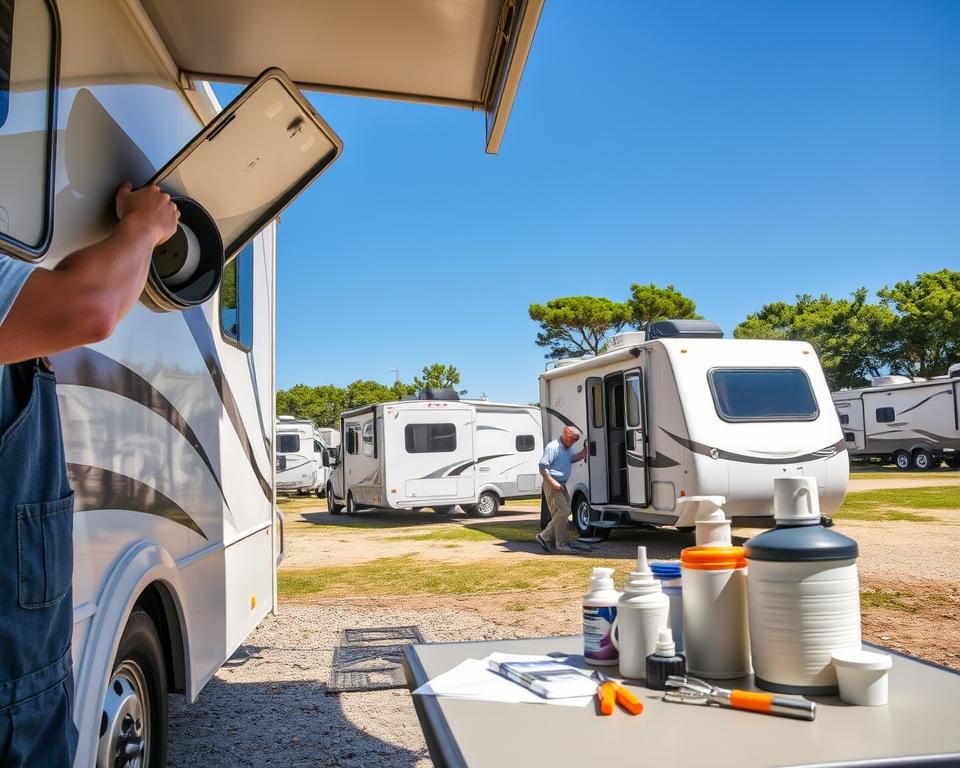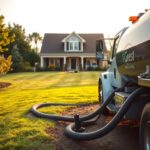RV Waste Tank Pumping: Vital Maintenance Advice
Imagine what happens when you ignore your RV’s sewer setup. Numerous campers feel intimidated by tank draining. However, realizing the importance of these maintenance practices is vital. These steps preserve your camping joy and avoid expensive repairs. Mastering correct waste handling is fundamental to your system’s longevity. Here are key pointers on RV black tank pump with upkeep advice to ensure your system operates flawlessly.
The Basics of Your RV Sewage System
Every recreational vehicle features a septic setup. It consists of a black tank for toilet use, a gray tank for sinks/showers, plus a freshwater reservoir. Grasping how each part works is key to proper black tank servicing and overall system care.
Drains and vents manage liquid and air movement throughout the system. Understanding this synergy helps you avoid blockages and buildup. It’s the foundation of a smooth camping experience.
Regular checks and care keep your tanks in top shape. Frequently checking tank levels and emptying on time preserves comfort. Proper upkeep extends tank life and enhances every journey.
Why Routine Tank Pumping Matters
Frequent tank pumping keeps your system working and clean. Leftover solids lead to smells and clogs, spoiling your trip. A full tank can produce embarrassing backups. These incidents mar your travel enjoyment.
Neglecting tank emptying invites expensive fixes. Damage from neglect can shorten component lifespan. Timely emptying keeps your plumbing running smoothly. You’ll avoid nasty surprises and costly breakdowns.
Staying on top of maintenance wards off backups. Investing in pump-outs shows you care about your RV. Your trips become more relaxing. A strict pumping routine lets you enjoy camping without septic concerns.
Recommended Pump-Out Intervals
Timing your tank dumps depends on several variables. Common guidance suggests a 3–5-day window. Still, it varies with tank size and occupancy. Pinpointing the correct dump time is key for effective wastewater management.
Empty once the black tank reaches roughly 66% full. It ensures good drainage and cuts down on odors. Skipping this leads to blockages and smells that spoil the trip.
Many elements can affect how often you pump:
- Number of people on board
- Length of stay
- Type of waste generated
- Tank capacity
Scheduling prevents on-the-road crises. Sync with any public dump station hours. Tracking your usage helps forecast dump needs.
| Usage Scenario | Pumping Frequency |
|---|---|
| Short Trip, Two Campers | Every 3–4 days |
| Extended Trip (4–6 people) | Every 2–3 days |
| Seasonal Use, Two to Four Campers | Weekly or Bi-Weekly |
Keep a close eye on tank levels and your habits. Staying attentive guarantees a pleasant trip.

Top Methods for Emptying Your Tanks
Proper methods stop odors, clogs, and expensive repairs. Begin with the black tank to avoid cross-contamination. This prevents dirty water from fouling the clean.
Using a high-quality hose minimizes leaks and ensures smooth dumping. Tighten connections to stop spills. Once both tanks are clear, rinse the black tank thoroughly. This removes residue and preps the tank for next time.
Scout dump spots along your route. Being prepared saves time on the road.
In short, follow these key steps for efficient dumping:
- Empty the black water tank first.
- Use a top-quality sewer hose.
- Flush the black tank thoroughly after emptying.
- Plan your dump station locations.
These tips refine your waste disposal process.
Proper Use and Maintenance of Your RV Tanks
Grasping correct handling of black and gray tanks ensures system health. Maintain a bit of water in the black tank to aid waste decomposition.
Don’t flush wipes, feminine products, or paper towels. Always use RV-safe toilet paper to prevent clogs. Inspect tanks often to catch problems early.
Occasional treatments boost system performance. They introduce microbes that digest solids effectively. Simple steps ensure smooth tank operation.
- Check for leaks and damage often.
- Apply RV-specific chemical treatments.
- Keep vents clear to avoid odors.
Adhering to these practices safeguards your system. You’ll enjoy more worry-free trips.
How to Pump Efficiently
To pump your tank effectively, follow a methodical approach. It’s essential to use designated dump stations. Know your tank’s capacity to avoid overflows.
Monitoring levels guides your dump schedule. This extends tank life and enhances trip comfort. Setting a dumping schedule improves system efficiency.
Rinse tanks thoroughly post-dump. This clears residue for more efficient future pump-outs. By applying these strategies, you’ll maintain your RV’s condition and comfort.
Common Mistakes to Avoid When Maintaining Your RV Septic System
Upkeep prevents trip interruptions. Insufficient flushing causes solids to accumulate. Adequate water use breaks down solids efficiently.
Flushing inappropriate items blocks pipes. Avoid non-dissolvable products like feminine hygiene items. Such mistakes can damage plumbing and inflate repair bills.
Keep the black tank valve closed until ready to dump. Premature opening prevents a full flush. This ensures solids clear on each dump.
Knowing these pitfalls helps maintain efficiency. Avoiding them keeps your waste management reliable.
When to Seek Professional Septic Services
Recognizing the need for expert help extends tank life. Lingering smells can mean serious tank problems. Slow drains point to potential clogs or buildup.
Waste spillage near dump sites signals trouble. It often calls for a deep professional clean. Pros blast away blockages to restore smooth flow.
Regular expert check-ups safeguard tank health. Early intervention avoids expensive failures. Hiring qualified technicians saves time and money long term.
Long-Term Maintenance for Your RV Wastewater Management
Smart upkeep ensures lasting system performance. Scheduled dumps preserve longevity and operation. Flushing often prevents buildup and costly repairs.
Adopting sanitation routines protects your system. Checking seals and joints avoids leaks. Opting for biodegradable products protects plumbing.
Keep these habits in mind:
- Stick to a pump-out timetable.
- Rinse often to remove solids.
- Sanitize twice a year.
- Inspect parts frequently for wear and tear.
Proactive care delivers worry-free travel. Through consistent upkeep, you’ll enjoy travel free from waste worries.
Final Thoughts
Effective RV septic maintenance is crucial for a pleasant experience. Understanding operation and following guidelines prevents headaches. Regular black tank maintenance improves efficiency. It enhances every mile.
Consistent inspections and care deliver trouble-free trips. This reliability supports every outing. These routines prime your rig for future rides. So you can focus on making memories, not dealing with tanks.


